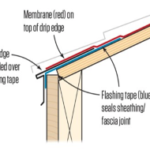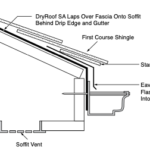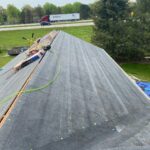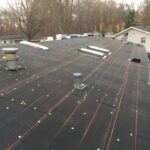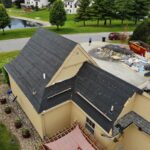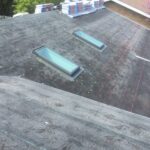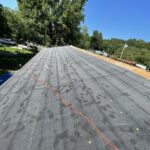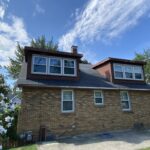Shingle Underlayment’s
Dennison Exterior Solutions as roofing contractors with almost 50 years of roofing installation experience specializes in installing our “Leakproof Roofing System” that includes using the waterproof shingle underlayment know as ice and water shield or WinterGuard.
Waterproofing Shingle Underlayment (WSU) is a very different kind of material. It is used in vulnerable locations on the roof deck that are most likely to leak during storms with high winds or when ice dams develop. Along the eaves, around roof penetrations and in the valleys are the areas most likely to require waterproof underlayment.
WHEN UNDERLAYMENTS ARE REQUIRED
The installation of water-resistant underlayment beneath shingles is required by many shingle manufacturers. Generally, CertainTeed recommends that underlayment be installed but does not require it except as noted below.
LOW SLOPE: All roof shingles applied to a low slope deck (2″ to below 4″ per foot) require the use of CertainTeed WinterGuard® Waterproofing Shingle Underlayment, or its equivalent,* applied over the entire deck surface. Consult the WinterGuard and individual shingle application instructions for details.
COLD WEATHER CLIMATES (ALL SLOPES): Application of WinterGuard or a waterproofing shingle underlayment meeting ASTM D1970 is strongly recommended whenever there is a possibility of ice build-up.
VALLEY FLASHING: Line valley by centering 36″ (915 mm) wide CertainTeed WinterGuard, or equivalent,*** in the valley and applying directly to deck. Consult the WinterGuard and individual shingle application instructions for details.
Water resistant underlayment is a product that consists of organic felt impregnated with asphalt saturant. Some water-resistant underlayments also contain a fiber glass reinforcement which increases tear strength and reduces wrinkling.
There are a variety of these underlayments made from different synthetic components. All are light-weight and claim superior resis- tance to tearing and wrinkling.
Water-resistant underlayment was originally invented to keep
the roof decking dry until shingles could be applied. Applying this underlayment was originally called “drying-in the roof.” It was also useful as a separation sheet between the roof sheathing boards (before OSB and plywood sheets were used as roof decking) and the asphalt shingles. This was important because resin pockets in the pine planks caused the asphalt to degrade prematurely unless the underlayment separated the resin and asphalt from each other.
Water-resistant underlayment is made to shed most of the water that falls on it unless it is torn or punctured. Its ability to be water- resistant is temporary. As the sun degrades the exposed asphalt the materials begin to dry, absorb more moisture, lose its strength and eventually begin to tear. The less asphalt used to saturate the under- layment sheet during manufacturing, the shorter its life. Since asphalt is the most expensive component of shingle underlayment, lower priced materials will have less asphalt and a shorter life when exposed to the sun. Lower priced shingle underlayment, for the same reason, is also subject to severe wrinkling when it gets wet or even just damp.
Underlayment is used under asphalt shingles for a variety of reasons, such as providing: Backup for water-shedding protection of the deck if shingles fail from wind-driven rain. The lower the slope, the more important underlayment is, since water flows more easily under shingles on low slopes. It is also used as an agent to hide minor imperfections of the decking material and reduce “picture framing” of deck panels.
Where is WinterGuard Used?
WinterGuard can be used on both new or existing decks. It is installed beneath shingles, slate, tile, or cedar shakes. Dennison Exterior Solutions installs WinterGuard over the entire properly ventilated roof deck.
WinterGuard is easy to apply and an excellent underlayment for low- slope shingle applications. It is commonly used to protect against water backup caused by ice dams at the roof eaves. It is also used in critical areas such as valleys, and as concealed flashing around roof penetrations and up sidewalls. In addition, WinterGuard is very useful on roofs exposed to occasional high winds where wind-driven rain can penetrate beneath shingles.
THE APPLICATION OF WINTERGUARD OVER OLD SHINGLES
WinterGuard must be applied over a clean, dry deck. Any other application, such as over old shingles, will void the WinterGuard warranty.
WHAT IS THE DIFFERENCE BETWEEN WINTERGUARD AND STANDARD UNDERLAYMENT?
All the No. 15lb. and No. 30lb. underlayment products will wrinkle somewhat when dampened. Some will wrinkle very badly. All felt underlayment’s can leak, especially if they are cut to make them lie flat after they have wrinkled, and they can leak around nails driven through them.
Waterproofing shingle underlayment’s, such as CertainTeed’s WinterGuard, do not wrinkle from moisture absorption. They do not need to be cut to flatten wrinkles, because when properly installed, there are no wrinkles. Once adhered, they will not blow off the roof. They do not leak around nails driven through them, because the thick layer of polymer-modified asphalt coating is designed to be sticky and flexible, so it seals around the nails that puncture it. Therefore, these underlayment’s are not just water-resistant, they are waterproof. But they must be applied fully adhered to a clean, dry wood deck, in accordance with the manufacturer’s specifications, in order to get the promised performance. And nails must be properly set according to manufacturer’s requirements.
Applying Drip Edge
- Drip edge must be applied so that the higher pieces will overlap the lower pieces.
- At the rake, drip edge may be installed under or over WinterGuard. When drip edge is installed over WinterGuard, the WinterGuard must cover the top of rake board.
- At the eaves, if there is a chance of snow or ice build-up in the gutters, install drip edge over WinterGuard. WinterGuard must cover top of fascia board. In severe ice dam regions, WinterGuard can be wrapped over the fascia board and, if desired, onto the soffit. Cover all exposed WinterGuard with drip edge, gutter, wood or other weather-resistant material to protect it from damage. If there is no chance of snow or ice build-up in the gutters, install drip edge under the WinterGuard.
- Dennison Exterior Solutions also wraps the waterproof underlayment over on to the fascia at the eave edges by about ½” to prevent ice back up under the drip edge from reaching the underside of the roof deck and preventing leakage into the soffit area.
